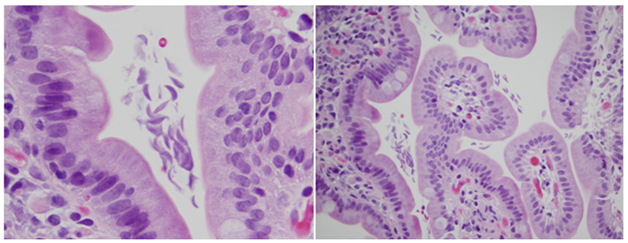eISSN: 2373-6372


Case Report Volume 6 Issue 4
1Sinai Hospital of Baltimore, USA
2Johns Hopkins School of Medicine, USA
Correspondence: Gerard E Mullin, Johns Hopkins School of Medicine, Baltimore, USA
Received: December 11, 2017 | Published: March 17, 2017
Citation: Singh R, Pezhouh MK, Mullin GE (2017) A Rare Approach of Diagnosing Giardiasis: Endoscopic Biopsy. Gastroenterol Hepatol Open Access 6(4): 00202. DOI: 10.15406/ghoa.2017.06.00202
Giardiasis, microbiome, endoscopy, irritable bowel syndrome, diarrhea
The prevalence of giardiasis in the USA has been estimated to be 2-5% of the population while The World Health Organization estimates the worldwide prevalence is 280million cases. Giardiasis is the most common parasitic infection of the gastrointestinal tract and tends to be a non-invasive infection that adheres to the duodenal epithelium. In children, giardiasis presents with abdominal pain, diarrhea malabsorption and failure to thrive.1 In adults, the infection tends to be asymptomatic or short-lived, however some have symptomatology that is often confused with the irritable bowel syndrome.
A 65year old female with gastroesophageal reflux disease (GERD) on longstanding omeprazole presented to an outpatient ambulatory surgery center for an upper endoscopy showing erosive esophagitis. Biopsies of the stomach and duodenum were unremarkable. The patient was advised to begin lansoprazole 30mg daily repeat the endoscopy in 6months due to her ongoing symptomatology which showed significant healing of the esophagus and a normal appearing duodenum. Biopsies of the esophagus demonstrated improvement but ongoing reactive epithelial changes and surprisingly, duodenal biopsies demonstrated Giardia lamblia infection (Figures 1A &1B). The patient underwent a stool test for Giardia antigen by enzyme immunoassay which confirmed the diagnosis. She was treated with a single dose of 2,000mg of Tinidazole with a stool antigen test showing resolution of her giardiasis.

Figure 1 Duodenal mucosa with numerous Giradia trophozoites (resembeling “falling leaves pattern”) at the luminal surface.
The conventional risk factors for acquiring giardia infection are due to fecal-oral transmission from person-to-person contact or contaminated water or food. We report a patient who is an elderly female, without known risk factors for giardia, was asymptomatic and acquired the infection sometime between her endoscopies over a 6 month period of time while being at home. Reports of giardia discovered on duodenal biopsy are rarely reported in the literature and usually in the setting of invasive disease and positive stool studies.2 Martinez-Gordillo et al.,2 described intraepithelial giardia in a child with chronic diarrhea and failure to thrive.2 Brandborg reported 6 cases of invasive giardia in symptomatic individuals with scores of trophozoites in the stool.3
Our patient was asymptomatic and without steatorrhea or other typical manifestations of giardia. Thus, this is a rare case report of an asymptomatic patient who was diagnosed with giardiasis duodenal biospsy. The duodenal biopsy showed normal villous architecture with no overall increase in inflammation. Numerous Giardia lamblia trophozoites were present in the lumen between the villi. These organisms usually appear as tear drop or pear shaped on histology. Duodenal biopsies should be analyzed for giardiasis as many cases are likely missed given that genotype Giardia duodenalis has been identified in up to 18.2% of a Brazilian population using molecular characterization.4
None.
Author declares there are no conflicts of interest.
None.

©2017 Singh, et al. This is an open access article distributed under the terms of the, which permits unrestricted use, distribution, and build upon your work non-commercially.